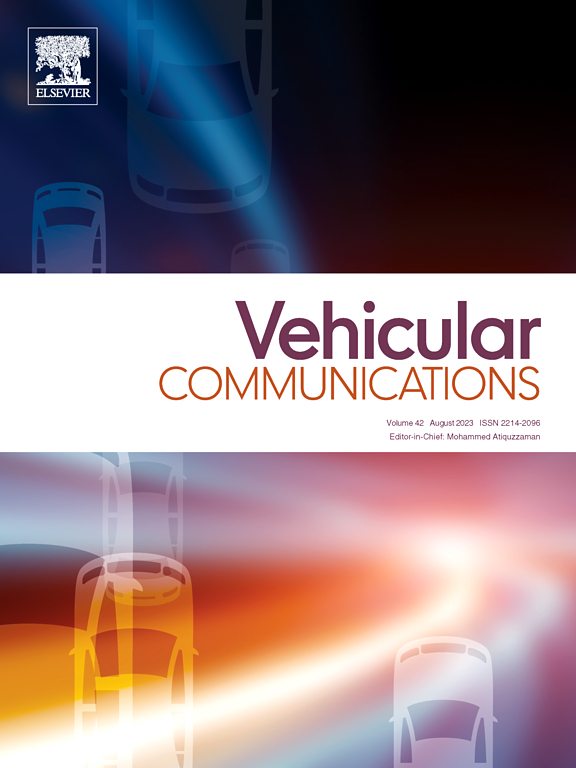无人机辅助空地一体化全双工 OFDMA 网络的联合子载波分配和功率分配
IF 6.5
2区 计算机科学
Q1 TELECOMMUNICATIONS
引用次数: 0
摘要
同时上行和下行传输引起的自干扰,以及小区间的同信道干扰,极大地挑战了未来多无人机辅助地空综合OFDMA网络全双工传输的优势。有效的资源分配对于在这些复杂的全双工环境中实现高系统性能至关重要。本文研究了子载波调度和功率分配的联合优化问题,这是一个由非凸服务质量(QoS)约束、目标函数的非凸性质以及子载波调度的组合复杂性所引起的复杂问题。为了克服这些困难,我们首先提出了一种基于交替优化(AO)方法的分时贪婪舍入算法(TS-GR)。为了进一步提高解的质量,我们还提出了一种基于lp范数的正则化算法(LP-NR)。大量的仿真结果和理论分析证实了我们提出的方法在无人机辅助下的全双工OFDMA网络中的收敛性和有效性。仿真结果表明,虽然TS-GR可以在宽松的QoS要求下实现更高的速率,但LP-NR通过始终满足上行链路和下行链路的QoS要求提供了稳健的性能。我们的研究结果表明,在最佳条件下,多小区全双工无线网络相对于半双工的增益是显著的,但可能受到高自干扰和噪声水平的限制。本文章由计算机程序翻译,如有差异,请以英文原文为准。
Joint subcarrier assignment and power allocation for UAV-assisted air-ground integrated full-duplex OFDMA networks
The self-interference caused by simultaneous uplink and downlink transmissions, along with inter-cell co-channel interference, significantly challenges the benefits of full-duplex transmission in future multi-UAV assisted Air-Ground Integrated OFDMA Networks. Effective resource allocation is crucial for achieving high system performance in these complex full-duplex environments. This paper investigates the joint optimization of subcarrier scheduling and power assignment, a task complicated by nonconvex Quality of Service (QoS) constraints, the nonconvex nature of the objective function, and the combinatorial intricacies of subcarrier scheduling. To overcome these difficulties, we first propose a Time-Sharing Greedy Rounding algorithm (TS-GR) based on the alternating optimization (AO) method. To further enhance the solution quality, we also propose an -norm regularization-based algorithm (LP-NR). Extensive simulation results and theoretical analyses confirm the convergence and efficiency of our proposed methods in UAV-assisted full-duplex OFDMA networks. The simulations highlight that while TS-GR can achieve higher rates under relaxed QoS requirements, LP-NR offers robust performance by consistently satisfying both uplink and downlink QoS requirements. Our findings demonstrate that the gains of multi-cell full-duplex wireless networks over their half-duplex counterparts are significant under optimal conditions but can be constrained by high self-interference and noise levels.
求助全文
通过发布文献求助,成功后即可免费获取论文全文。
去求助
来源期刊

Vehicular Communications
Engineering-Electrical and Electronic Engineering
CiteScore
12.70
自引率
10.40%
发文量
88
审稿时长
62 days
期刊介绍:
Vehicular communications is a growing area of communications between vehicles and including roadside communication infrastructure. Advances in wireless communications are making possible sharing of information through real time communications between vehicles and infrastructure. This has led to applications to increase safety of vehicles and communication between passengers and the Internet. Standardization efforts on vehicular communication are also underway to make vehicular transportation safer, greener and easier.
The aim of the journal is to publish high quality peer–reviewed papers in the area of vehicular communications. The scope encompasses all types of communications involving vehicles, including vehicle–to–vehicle and vehicle–to–infrastructure. The scope includes (but not limited to) the following topics related to vehicular communications:
Vehicle to vehicle and vehicle to infrastructure communications
Channel modelling, modulating and coding
Congestion Control and scalability issues
Protocol design, testing and verification
Routing in vehicular networks
Security issues and countermeasures
Deployment and field testing
Reducing energy consumption and enhancing safety of vehicles
Wireless in–car networks
Data collection and dissemination methods
Mobility and handover issues
Safety and driver assistance applications
UAV
Underwater communications
Autonomous cooperative driving
Social networks
Internet of vehicles
Standardization of protocols.
 求助内容:
求助内容: 应助结果提醒方式:
应助结果提醒方式:


